The Community Lower School
The Community Lower School teaches elementary children with learning disabilities and attention issues how to learn, and does so in a supportive atmosphere that encourages independence and self-confidence. The Community School concept proved that many of the emotional and behavioral problems so often associated with academic delays could successfully be resolved within a larger therapeutic environment.
With a variety of academics presented in a small classroom setting, children are able to learn content despite their disabilities and learning differences. Related services are also offered to remediate delays in reading, speech and language and more.
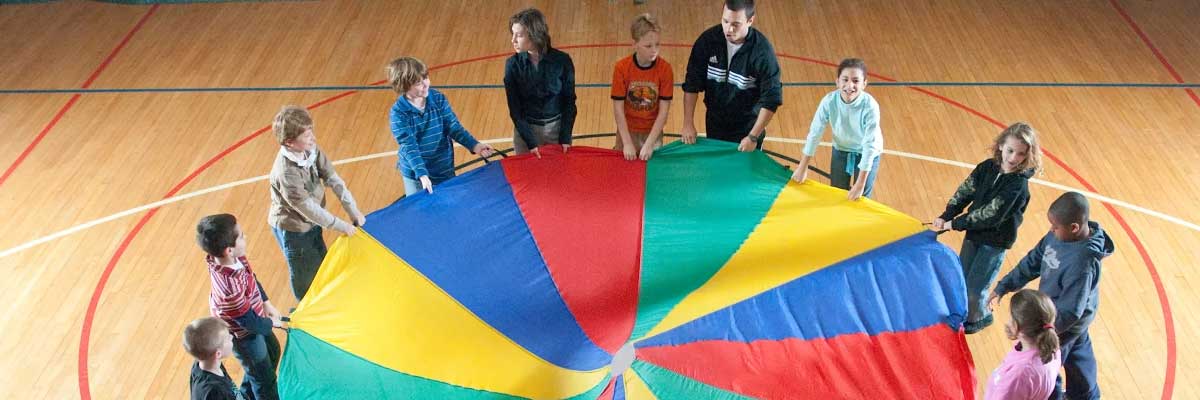
Admissions
Thank you for your interest in Community School. Please take a few minutes to view our website, particularly our Frequently Asked Questions (FAQ's). In addition, we hope you will join us at an Open House to tour our school, view our students and teachers in the classroom and learn more about our exceptional program.
Applications are accepted throughout the school year. Enrollment is open to both private students and public school students in New York and New Jersey.
Our application process has several steps:
- Attend an Open House (Parents Only).
- Fill out the Application Form.
- Submit the following documents:
- Psychological Report
- Educational Evaluation
- IEP (Individualized Education Program)
- Any additional diagnostic testing
- Completed Application form
- Non-Refundable application fee of $65.00
- Review by the Admissions Committee: The completed application packet is reviewed by members of the Admissions Committee to determine how each child learns and where he or she fits into the continuum of learning. The Admissions Committee will determine the following: Will the student benefit from the Community School program? Is there space in the appropriate grade for the student?
- Parent / Student Interview and School Visit: If a possible match is indicated, an appointment will be made for the parent and prospective student to meet the Director of Education for an interview.
- Notification: The Admissions Committee will send a letter to notify the parent/guardian of the decision. The application process involves an interview with parents, applicant and placing professionals; a review of school records and clinical evaluation; informal testing when necessary, and the observation of students in the school setting. Acceptance is not competitive. Students are selected on the basis of their ability to benefit from the Community School program. It is advisable to apply early, since space is generally limited.
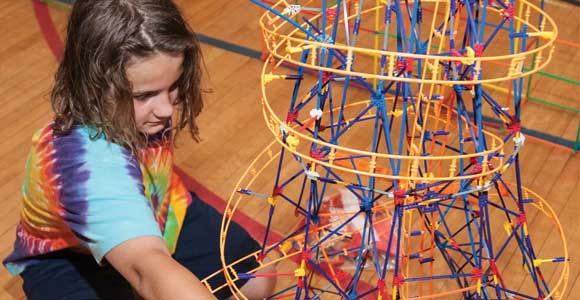
GUIDANCE
An important objective of the Community School program is to develop self-esteem in our students, encourage productive coping strategies and reduce negative and self-defeating attitudes.
Problems such as restlessness, limited attention span, poor organizational ability, low frustration level, impulsiveness and poor social perception require constructive attention. Skilled teaching, a therapeutic environment in the classroom and the sensitive intervention of teachers provide the major means for addressing these problems.
FAQ about the Lower School
Lower School Staff
The Lower School Curriculum
MATHEMATICS
Mathematics is taught in small to medium sized groups of children, clustered according to level, instructional needs and learning style. To ensure comprehension, new material is taught through the use of concrete aids. Emphasis is placed on number fact acquisition to the greatest extent possible without sacrificing advancement to new knowledge. The use of calculators is encouraged when appropriate.
Problem solving, mental arithmetic, applications and practical skills such as money, time, calendar, weight and measurement are also considered. During these skill building lessons, the language of mathematics as well as math concepts and processes are introduced, defined and frequently revisited and reviewed to ensure retention. Lessons are presented in a multi-sensory approach and technology is used when appropriate.
SCIENCE AND SOCIAL STUDIES
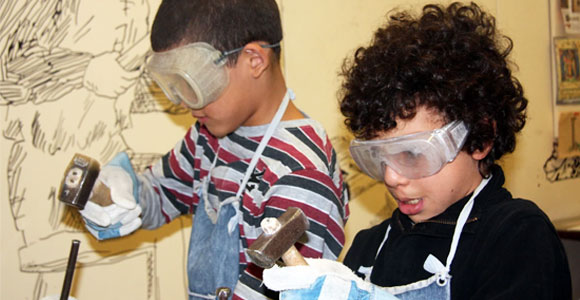
Science and Social Studies help children acquire information, develop skills and foster thinking and creativity. Every attempt is made to follow a logical sequence of topics and to relate the instruction to the common core curriculum standards.
Of great importance is the opportunity to involve the children in discussion, reflection, writing, reading, study skills development, trips, projects and experiences of many kinds. In addition, geography is taught to develop skills in map reading and graphic aid interpretation as well as to expose children to aspects of other cultures.
TECHNOLOGY PROGRAM
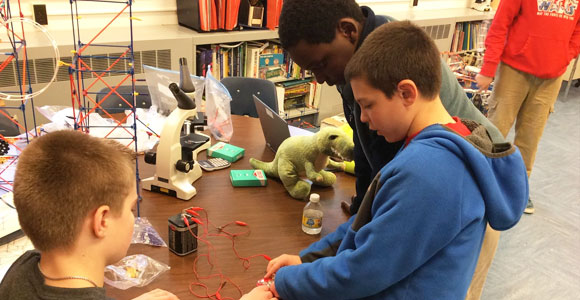
The Technology Program is designed to ensure literacy in computer technology and develop a comfort level with a variety of Web 2.0 tools and software programs. Word processing is used widely across the curriculum.
When developmentally appropriate, students learn to manipulate, analyze and organize information from a variety of sources, acquire the skills to combine text, graphics and sound in reports and presentations, and develop effective communication and research skills. Our students readily learn digital file management skills and how to navigate the internet productively and safely.
Community School supports the use of assistive technology in the classroom and provides students with the necessary tools to be successful. Technology plays a critical role in providing our students with assistance in researching, reading, writing, conceptualizing and organizing their ideas. The Community School is 1:1 with laptops in every classroom. Each student is provided a Google account with access to various tools to support reading and writing including text to speech, speech to text, word prediction and more. These accounts allow students to access tools at any time from any device. iPads are also used to enhance the speech and technology curricula.
Smart Boards are used to enhance learning. Teachers are able to make learning more interactive and visual via Smart Board technology which is made available in every classroom. Student engagement is increased through the use of websites, videos and various learning activities.
ENGLISH LANGUAGE ARTS
Reading is taught in small groups of students who present with similar reading levels and instructional needs. Teachers utilize a variety of programs and materials tailored to meet the individual needs of the students. Our goal is to engage students in the active process of reading for meaning as well as to develop essential word identification skills. Both groups and individuals proceed at their own rate. Students may move from level to level as rapidly as their skill development dictates.
Students work on decoding, fluency, comprehension, vocabulary and spelling skills. Reading fluency is developed through age appropriate high interest stories. Specific methods are also employed to develop comprehension. Students are taught story elements, main idea, supporting details, how to summarize, predict and infer. New vocabulary and spelling are presented in a structured way. Community School's reading instructors are adept at using multi-sensory methods. All techniques are reinforced throughout the entire Community School curriculum and all skills are practiced, reviewed and repeated to promote mastery.
The specialized Wilson Reading Program is used when appropriate for the student. It is based on building a network of sound-symbol association using visual, auditory, kinesthetic, and tactile modalities. It is a highly structured, step-by-step approach utilizing sight word instruction, vocabulary, oral expressive language development and comprehension in which each step builds on previous accomplishments.
Language Arts in all its aspects, receptive language, expressive language, grammar and the mechanics of written language, are addressed across the curriculum. Grammar is integrated with the writing process as a practical tool. Strategies for effective writing are developed. Writing instruction emphasizes the process of writing. Assignments are broken down in a step by step manner. Lessons include teaching students the brainstorming process through group activities, completing graphic organizers to help with sequencing, generating outlines, a rough draft, editing and publishing a final copy. Assistive technology and laptops are available for all students when needed.
THERAPY PROGRAMS
Speech and language is offered as prescribed, either in small groups or in individual sessions. Instruction is focused on the development of receptive language, expressive language, social skills and articulation.
Visual-Motor class is offered on an individual and/or small group basis. Lessons focus on improving handwriting, keyboarding skills and copying from the board. The Handwriting Without Tears program is utilized.
HEALTH AND PHYSICAL EDUCATION
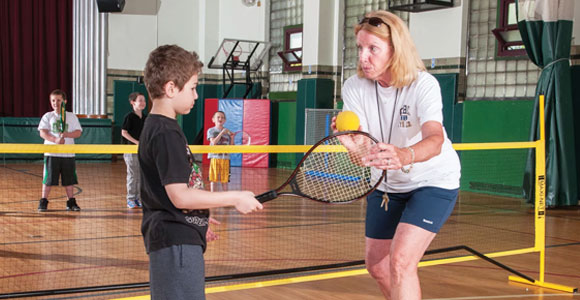
Health classes are offered in a small group setting. Topics discussed include family life, body systems, personal hygiene, nutrition, safety and alcohol, drug and tobacco abuse. Methodology includes use of videos, interactive activities, Smart Boards, lectures, demonstrations, discussions and paper and pencil activities.
Physical Education, on a frequent schedule, is designed to develop gross motor skills, teach team sports and foster good sportsmanship. Cooperative activities are included in the Physical Education Program to foster cooperation rather than competition. The activities build self-esteem, self-awareness, self-reliance and support for others.
Google Workspace for Education
Google Workspace for Education provides students and staff with a set of Google tools that help us collaborate, streamline our instruction and keep our learning safe. Its integration with our 1:1 Chromebook program is key to helping our students maintain the consistency and organizational skills necessary for their success.
Lower School Calendar
Calendar at a Glance
Our Documents & Forms list above contains a handy one-sheet "Calendar at a Glance" for hanging on the fridge!
